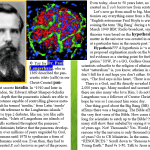[Originally published in 2014 as First Day of Class]
Today was my first day of teaching general chemistry at Anderson University. I started the class with a little demo.
Prior to class, I had soaked a Q-tip in a slightly acidic solution of phenolphthalein, an acid/base indicator. In the presence of an acid, it is clear. In the presence of a base, it is pink. I used the Q-tip to write the name of the course (Chem 2110) on a large sheet of paper, and it dried clear. I soaked another Q-tip in a solution of potassium ferrocyanide (which is a light yellow color) and wrote my name on the same piece of paper, right over where I had written the course name. It also dried clear. When I set it up, then, the students saw a blank sheet of paper.
I then sprayed the paper with a very weak solution of sodium hydroxide. The base caused the phenolphthalein to turn pink, revealing the class name. It had no effect on the potassium ferrocyanide. I then sprayed the paper with a weakly acidic solution of iron (III) chloride. The acid caused the phenolphthalein to turn clear again, so the course name went away. The iron (III) chloride reacted with the potassium ferrocyanide to bring out my name in blue. I love that demo, and at least a few of the students seemed to appreciate it.
After going over the syllabus and discussing the mechanics of the course, I decided to start by giving one of the best descriptions of science I have ever heard. It comes from Dr. Henry F. Schaefer III, the Graham Perdue Professor professor of Chemistry at the University of Georgia. He is one of the most important chemists of our time, and here is what he says about science:1
The significance and joy in my science comes in those occasional moments of discovering something new and saying to myself, ‘So that’s how God did it.’ My goal is to understand a little corner of God’s plan.
I told the students that, as far as I am concerned, this is what science is all about — figuring out how God did it and trying to understand a small piece of God’s amazing plan for His creation. I then went on to discuss the introductory material for the course.
I was pleased to find out that 2 of the 61 students in my class had used my high school chemistry book! I wrote that book to prepare students to study chemistry at the college level, and I have received many notes from students, parents, and teachers indicating that it has. It will be interesting to see whether or not these two students have a similar experience.
It looks like the semester is off to a good start!
REFERENCE
- Sheler, J. L. and J.M. Schrof, “The Creation,” U.S. News & World Report (December 23, 1991), pp 56-64.






